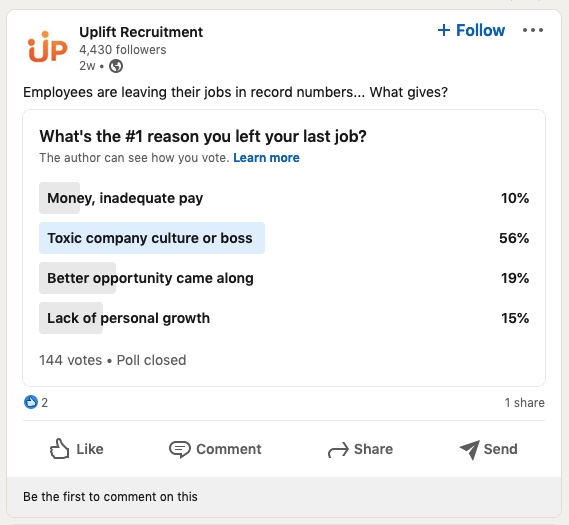
How to Deal with Toxic Workplace or Boss
Of 144 people polled on our LinkedIn company page, 56% of you said the #1 reason you left your last job was a toxic work culture or boss.

Due to this overwhelming response, we want to talk about toxic workplaces: in this article, you will learn how to recognize one and know what to do about it.
…
The global pandemic shined a spotlight on mental health and workplace wellbeing as we suddenly met all sorts of new challenges related to work and life. When the dust settled, many people walked away with new insights about how they liked to work and be treated in a professional environment. This new perspective was the partial cause of the Great Resignation – a movement where large numbers of people left their current job – because employees were finally aware they had a choice. After everything that happened with COVID-19, toxic bosses, unhappy work cultures, and gruelling schedules were out. People decided to put their mental health first.
Statistics mirror this trend with 91% of people saying they believe mental health in the workplace is important (88% believe physical safety is important)*. Despite this, only 52% of employees believe their workplace is mentally healthy compared to 76% for physical safety.*
If your workplace reality doesn’t meet your expectations in terms of mental health, it is time to make a change and look for a new role.

Why Does It Matter?
- One in five Australian employees report that they have taken time off work due to feeling mentally unwell in the past 12 months.
- It is estimated that untreated mental health conditions cost Australian workplaces approximately $10.9 billion per year
- Mentally healthy workplaces are important to workers (91% agreement among employees, 89% among leaders)
- A widespread perception that organisations that value mental health are likely to be more productive (72% agreement among employees, 71% agreement among leaders)
- Organisational leaders who focus on mental health in the workplace inspire respect among employees (65% agreement among employees).
How to Tell if Your Workplace or Boss is Toxic?
- High Employee Turnover – Are employees constantly coming and going? This is a big red flag that something is wrong. Organisations that foster a warm, welcoming work culture see drastically less turnover.
- No One is Excited to Be There – The best companies have employees that shout from the rooftops about how good they have it. Think Google, Shopify, or Atlassian. Organisations where no one is happy and bad attitudes prevail, tend to breed more of the same and be less productive overall.
- Employees are Afraid to Fail, and Therefore Afraid to Act –
Psychological fear makes a workplace untenable. If you are too afraid your boss will scream at you if you make a mistake you’ll never take any risks. This kind of environment is toxic and stifles innovation.
- Unclear Roles and Responsibilities Lead to Chaos
Power struggles, miscommunication, and a general feeling of confusion are common in toxic workplaces. Likewise, collaboration and opportunities to spearhead change are rare.
- Office Gossip and Workplace Bullying are Common
Rumours, trash-talking, and vindictive exchanges are rampant in toxic workplaces. If your office feels like a reality-TV show, you know it’s time to get out.
What Do You Do If Your Workplace is Toxic?
- Find Your People
If you find yourself working somewhere toxic, your first order of business is to build a network of trusted co-workers. Find one or two work friends that can support you, commiserate, and totally understand what you are going through even when your real-life friends and family do not. Here’s how you can support someone who is struggling in your office.
- Focus On What You Can Control: Your Goals
If you are spiralling into a deep, dark depression over where you work, STOP. While you can’t control anyone or anything that happens at work, you can control how you feel about it. If spending some amount of time in a toxic workplace is essential to your goals, then just keep your plans at the front of your mind and avoid sinking into the toxicity by refusing to engage with negativity or gossip.
- Give Honest Feedback
Gather your courage and let the management know what’s really going on during your performance review, exit interviews, any other opportunity. C-Suite and management may not even be aware of the negativity circling and you may be a lifesaver for your colleagues.
- Move On and Seek Out a Healthy Organisation
If all else fails, do what 56% of our readers have done: leave. There are very few reasons to live your life surrounded by negativity and drama. Be sure you ask in your interviews about company culture and how your prospective organisation handles toxic situations. Look for a place to work that has a well-outlined policy for onboarding, company culture, and handling conflict. The more the management has thought about potential situations, the better.
In the end, the best way to escape a toxic workplace is to find a new one. If you need help with that, contact us with your CV at hello@upliftrecruitment.com.au We vet our clients and if we get reports they aren’t a very nice place to work, we drop them. We get candidates and want you to find a place to work that is healthy and prosperous for all parties in the long run.
